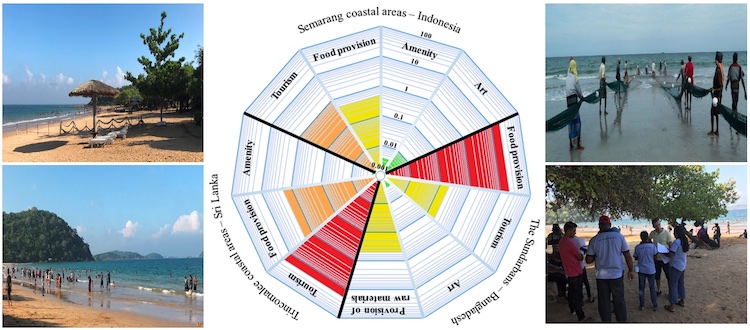A. Mehvar* (former PhD researcher)
University of Twente,
IHE Delft Institute for Water Education
Introduction
The impacts of Climate Change (CC) threaten the coastal wetlands and affect Coastal Ecosystem Services (CES) that are vital to human well-being. Quantification of the value of CC-driven environmental losses is scarce, especially in coastal areas of developing countries which have relatively low adaptive capacity to CC impacts. Addressing this knowledge gap, a practical framework to Quantify Climate change driven Environmental Losses (QuantiCEL) was developed and applied in coastal areas in Southeast Asia (i.e., Indonesia, Bangladesh, Sri Lanka). Using this framework, the likely physical impacts of climate-driven hazards (i.e., SLR-induced inundation, and coastline recession) on diverse ranges of ecosystems (i.e., mangroves, beach and dune systems, pelagic system) and provided goods and services (i.e., food provision; tourism; art and aesthetic values; provision of raw materials) were assessed for different impact scenarios in 2100, and corresponding damage values of CES were quantified in monetary terms.
Methods
The QuantiCEL framework (Mehvar et al., 2019) is based on an integrative socio-ecological-economic approach consisting of three coherent steps: (i) Economic valuation of CES by using the standard economic valuation methods; (ii) Identification of the CC-driven impacts on CES by determining hazards and the affected areas for each scenarios via digital elevation maps and satellite images, as well as using primary and secondary data; and (iii) Monetizing the impacts and quantifying the changes to the total CES value by linking the results of the previous two steps.
Results
The application of this framework for the selected case studies showed that, where the absolute loss value of CES by the end of the 21st century is concerned, food provision and tourism are the CES with higher loss values. However, art, amenity, and tourism are the highly affected CES where the percentage loss (by the end of the 21st century) relative to the present-day value of CES is concerned.

Figure: Photos taken during data collection phase; and schematic representation of the absolute loss value of CES in logarithmic scale, in million US$ (from 0.001 to 100) for the three case studies. 'Green' to 'dark red' colours represent low to extreme loss values.
References
Mehvar, S., Dastgheib, A., Filatova, T., and Ranasinghe, R. (2019). A practical framework of quantifying climate change-driven environmental losses (QuantiCEL) in coastal areas in developing countries. Environmental Science and Policy, 101, 302-310.
I. Surname1*, F.N. Another-Surname2 , Y. Next-Surname2
1 University Name, Country; 2 Organization Name, Country
* Corresponding author: mail.name@organization.org


